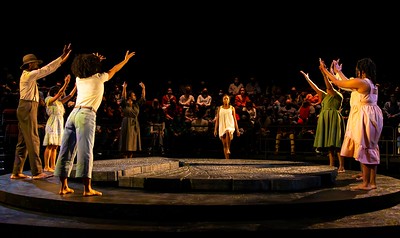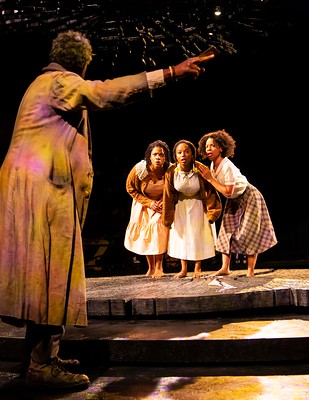
The cast in The Huntington’s production of The Bluest Eye by Lydia R. Diamond; Photo by T Charles Erickson.
Presented by The Huntington
Based on the American classic novel by Toni Morrison
Written by Lydia R. Diamond
Directed by Awoye Timpo
Choreography by Kurt Douglas
Music direction by David Freeman Coleman
Original music by Justin Ellington
Dramaturgy by Sandy Alexandre
Intimacy direction by Ayshia Mackie-Stephenson
January 28 – March 13, 2022
Digital access available through March 27, 2022
ASL-INTERPRETED PERFORMANCE: Friday, February 11 at 8pm.
OPEN CAPTIONED PERFORMANCE: Tuesday, February 15 at 7:30pm.
AUDIO-DESCRIBED PERFORMANCE: Saturday, February 26 at 2pm
Calderwood Pavilion at the BCA
Boston, MA
The Huntington on Facebook
The Bluest Eye plays in approximately one hour and 40 minutes with no intermission.
Content warning: every kind of violence amidst a Black community
Critique by Kitty Drexel
“Coming together in a circle to tell a story is essential to our humanity. That’s what we’re inviting the community into with The Bluest Eye.” – Director Awoye Timpo
Boston, MA — The synopsis for The Bluest Eye would have a newcomer believe that the play is about unattainable, western i.e. colonialist beauty standards. It is, but The Bluest Eye is about much more.
Pecola Breedlove (Hadar Busia-Singleton) has come to stay with Claudia (Brittany-Laurelle) and Freida (Alexandria King). We learn through Claudia’s narration all about the Breedloves. Mrs. Breedlove (McKenzie Frye, who tears the roof off in her role) and Mr. Cholly Breedlove (Greg Alverez Reid) are scarred from growing up in the Midwest.
Through an examination of their stories, we come to understand Pecola and why she dreams of having blue eyes. Ramona Lisa Alexander, Brian D. Coats and Lindsley Howard round out the cast. The cast is excellent together and individually in their own right.
The Bluest Eye is about a poor, Black community in Ohio responding to incest. It is about the experience of being shunned by white people for existing while Black, poor, female and young. It is about the irresponsibility of christian, white culture for systematically shunning Black people. It’s about intergenerational pain passed through the blood.
Sandy Alexandre’s dramaturgical essay “How To Look Better” in the show’s playbill is excellent. Alexandre breaks down the cultural and social mores that plague Pecola’s existence and lead to her tragic end. It is thoughtfully informative and emotionally accessible. Its syntax is approachable and its tone relatable.
The staging and choreography of Timpo and Douglas (assisted by the music direction of acapella gospel music by Coleman) work together to highlight the performers’ best work and reveal the social nuances of Morrison’s novel. The Bluest Eye is performed in-the-round so audience members can see each other through the on-stage action across the stage. The lights come up at pivotal moments and we, the audience, must look each other in the eyes as horrible things happen. We can’t stop it; it isn’t our faults and yet, somehow, it is.
On a personal note, it is really good to see Kurt Douglas’ work on the Huntington’s stage. Douglas and I went to BoCo together for a few years when it was still The Boston Conservatory. Although we were but wee babies at the time, Douglas’ talent as an artist and a human was obvious to anyone who knew him. It warms the cockles of my heart to see his work on the local stage. (I don’t expect that he remembers me. I was one of many, mousie voice students whose tuition paid BoCo’s rent.)
The Bluest Eye is paced well until about 15 minutes until the end. Diamond, Timpo and Douglas set up the story to flow gracefully from the beginning. Bumps and thorns seize the characters and fall away. Soapbox Church is introduced, we learn why he is significant to Pecola and then, all of sudden, without an arc or tie-in, the play winds down.
There is no time to process the big reveal (or the jaw-dropping, situational lighting design by Adam Honoré and set design by Jason Ardizzone-West), no transition time for the audience. We don’t know what we saw. We need to know what we saw. It’s a play.
Toni Morrison does not shy away from violence, but she doesn’t glorify it. Her characters live through racial, domestic, sexual, economic, physical and emotional violence. Morrison writes about violence as a matter of fact. That isn’t critical race theory; that’s the truth Black people tell us.

Brian D. Coats, Brittany-Laurelle, Hadar Busia-Singleton, and Alexandria King in The Huntington’s production of The Bluest Eye by Lydia R. Diamond. Photo: T Charles Erickson.
The Bluest Eye is violent. Violence arrives early and stays like an uninvited visitor. The characters aren’t always fighting each other, but they are always fighting a losing battle against white supremacy. Understanding this is tantamount to appreciating the Huntington’s production.
Reading (or rereading) Toni Morisson’s novel, The Bluest Eye will help audience members better understand the stage play. The play follows the novel fairly religiously. It adds nothing and takes nothing out. Scenes that are separated in the novel are joined in the play for purposes of continuity. Some scene’s are embellished marginally for a viewer’s understanding but are otherwise unadulterated. Lydia R. Diamond takes what The Bluest Eye novel is, its essence, and translates it to the stage. It doesn’t feel like the novel; it is something complete in itself.
For Black lives matter, we must believe that they matter in our own home. When theatres consistently cast from the local acting population, they communicate that Black Lives Matter at home.
